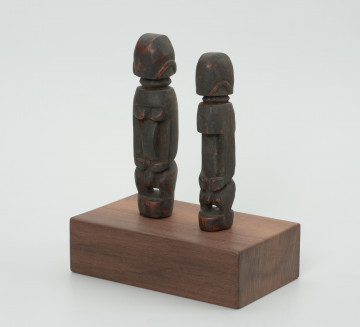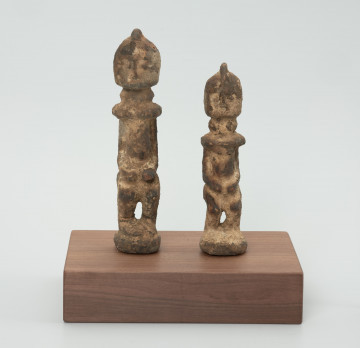
Divination set
między 1951 — 2000
National Museum in Szczecin
Part of the collection: Collection of Dogonian art
The Dogon know many methods of divination, including kauri shells, the arm, the hand, the position in which a sacrificial animal dies, dreams and fox tracks. One of the older methods found throughout West Africa is the art of divination called wanu. The diviner turns to the ancestors and the most important beings in the Dogon religion - the Nommo to answer a question. These are four pairs of twins created as the first beings, just after the Earth, Heaven and Water by Amma - the creator god, also considered water deities. During the séance, the fortune-teller uses kauri shells, wet stones and small figurines. According to Dogon mythology, the wooden fortune-telling statues symbolise the figurines that Andumbulu and Yeban - gnomic deities to whom personal and family problems are entrusted - gave to each other in mythical times. The fortune-teller takes the kauri or pebbles in his right hand and lowers them onto his left hand or throws them onto the ground, observing their form arrangement. This method of divination is often used to determine nanie - the reincarnation of a child. The Dogon believe that every person is an incarnation of their ancestor, with the distinction that women are the nana of female ancestors and men of male ancestors. A deceased ancestor selects his future incarnation by touching the belly of a pregnant woman. It happens that the ancestor dreams of the future mother, who already knows from whom her child will inherit nanie. If the parents do not know whose incarnation their child will be, they go to a fortune-teller who, through wanu or a fortune from the traces of a fox, tells them of which ancestor their child is an incarnation. When the child's father finds out that the child is an incarnation of his deceased father, he says the following words: mu ba todo nana, which means 'he has been born to replace my father'.
Katarzyna Findlik-Gawron
Author / creator
Dimensions
cały obiekt: height: 11,4 cm, width: 16,2 cm
Object type
figure
Creation time / dating
Creation / finding place
Identification number
Location / status

między 1951 — 2000
National Museum in Szczecin

między 1951 — 2000
National Museum in Szczecin

między 1951 — 2000
National Museum in Szczecin
DISCOVER this TOPIC
Museum of King Jan III's Palace at Wilanów
DISCOVER this PATH
Educational path